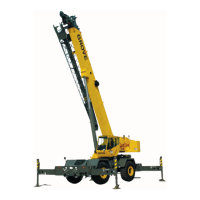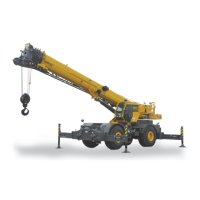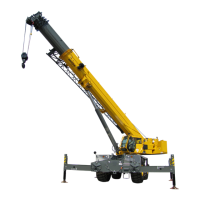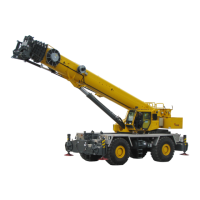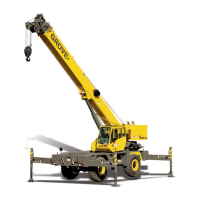HYDRAULIC SYSTEM RT880E SERVICE MANUAL
2-16 Published 11-10-2014, Control # 524-00
Pump No. 1 Bleeding and Start-up
1. Ensure reservoir is filled with the proper hydraulic fluid to
the high level mark on the reservoir sight gauge. If
hydraulic oil is aerated (oil has a foamy white tint with
bubbles), allow crane to sit until the air has escaped and
the fluid is a dark solid color.
2. Remove the plug from the Dr port of the pump
(Figure 2-7). Fill the pump casing with hydraulic oil, then
re-install plug; torque plug to 123 lb-ft (166.8 Nm).
3. Place an adequate container under Pump No. 1 to catch
the hydraulic oil. Remove the plug from the pump’s Tair
port (Figure 2-7).
4. Remove the breather from the Hydraulic Oil Reservoir,
then install the Pump Priming Tool (Figure 2-8) (Grove
P/N 80030367) onto the reservoir in place of the
breather. Connect a compressed air supply (nominal
100 psi (6.9 bar), maximum 300 psi (20.7 bar)) to the
Pump Priming Tool.
5. Wait for a solid stream of fluid, free of air bubbles, to exit
the Tair port, then re-install the plug in the Tair port while
oil is still coming out; torque plug to 9 lb-ft (12.2 Nm).
6. Remove the air supply from the Pump Priming Tool.
7. Start the engine and do the following:
a. Idle engine for two to three minutes with no
functions actuated. Check for leaks and repair if
required. Lay hand on pump to check for excessive
heat build-up. If the pump section is too hot to keep
your hand on, stop immediately. If the pump makes
excessive noise it is probably sucking air, which
prevents the pump from priming. If this occurs, stop
engine, and inspect all connections of the suction
hose/tube for a loose connection, or a missing or
damaged O-ring. Re-start the engine and run until
the pump takes prime for a maximum of 30
seconds. If the pump does not prime in 30 seconds,
stop the engine and repeat procedure until the
pump primes.
b. Increase the RPM to 1500-1800 for 1 to 2 minutes
with no functions actuated and make checks again
as outlined in step a. Incrementally increase throttle
to full RPM and then cycle the functions that the
pump supplies to verify proper speed. Verify pump
flow.
8. Check pressure settings; refer to Pressure Setting Pro-
cedures, page 2-21.
Pump No. 2 Bleeding and Start-up
1. Ensure reservoir is filled with the proper hydraulic fluid to
the high level mark on the reservoir sight gauge. If
hydraulic oil is aerated (oil has a foamy white tint with
bubbles), allow crane to sit until the air has escaped and
the fluid is a dark solid color.
2. If gear pump is equipped with 7/16-20 UN-2B port(s) in
the inlet side of the pump housing, place an adequate
container under Pump No. 2 to catch the hydraulic oil
and then remove the plug from this port (if the pump has
more than one gear section, remove the plug that is
most convenient as they are common to the inlet).
If gear pump is not equipped with 7/16-20 UN-2B ports
in the inlet side of the pump housing, place an adequate
container under Pump No. 2 to catch the hydraulic oil
and then slightly loosen the inlet port hose.
3. Remove the breather from the Hydraulic Oil Reservoir,
then install the Pump Priming Tool (Figure 2-8) (Grove
P/N 80030367) onto the reservoir in place of the
breather. Connect a compressed air supply (nominal
100 psi (6.9 bar), maximum 300 psi (20.7 bar)) to the
Pump Priming Tool.
CAUTION
Do not feed hot hydraulic oil into a cold pump. This may
cause the pump to seize.
CAUTION
Failure to follow this procedure can cause the pump to fail
CAUTION
The Pump Priming Tool is set to 1-2 psi to prevent the
reservoir from being over-pressurized and damaged. Do
not adjust the Pump Priming Tool. Always monitor the
pressure gauge of the Pump Priming Tool to ensure that 2
psi is not exceeded during the air bleeding process.
CAUTION
Failure to follow this procedure can cause the pump to fail
CAUTION
Do not retract hydraulic cylinders with the pump priming
tool connected to the reservoir. Damage to the reservoir
may occur due to the priming tool’s inability to properly
vent the reservoir of air.
CAUTION
The pump priming tool is set to 1-2 psi to prevent the
reservoir from being over-pressurized and damaged. Do
not adjust the pump priming tool. Always monitor the
pressure gauge of the pump priming tool to ensure that 2
psi is not exceeded during air bleeding.
